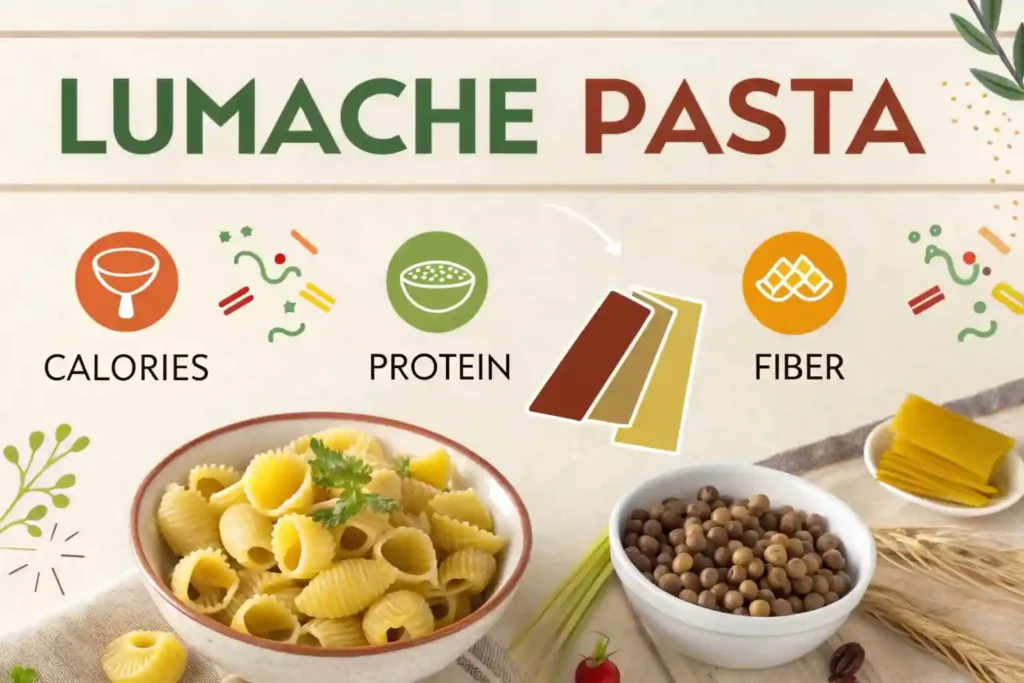Table of Contents
1. Introduction to Lumache Pasta
Lumache pasta, with its unique shell shape, is a delightful addition to any pasta lover’s repertoire. Originating from Italy, this pasta is not only visually appealing but also versatile in its culinary applications.
- What Makes Lumache Special?
- The name “lumache” translates to “snails” in Italian, aptly describing its shell-like form.
- Its shape allows it to hold sauces beautifully, making every bite flavorful.
- Lumache pasta is often used in baked dishes, salads, and hearty sauces, making it a staple in Italian cuisine.
- Culinary Significance
- Lumache is celebrated for its ability to pair well with a variety of ingredients, from rich meats to fresh vegetables.
- It is a favorite in both traditional and modern Italian cooking, showcasing the adaptability of this pasta shape.
- Why You Should Try Making It at Home
- Making lumache pasta from scratch allows you to control the ingredients and customize flavors.
- Homemade pasta has a fresher taste and a unique texture that store-bought options often lack.
- The process of making pasta can be a fun and rewarding culinary experience.
2. How to Make Lumache Pasta from Scratch
Creating your own lumache pasta at home is easier than you might think. With just a few simple ingredients and some basic techniques, you can enjoy fresh pasta that elevates any meal.
2.1 Ingredients Needed
To make lumache pasta, you will need the following ingredients:
- Flour: 2 cups of all-purpose flour or semolina flour for a firmer texture.
- Eggs: 3 large eggs, preferably at room temperature.
- Salt: 1/2 teaspoon to enhance flavor.
- Water: A few tablespoons, if needed, to adjust the dough consistency.
- Olive Oil: 1 tablespoon for added richness (optional).
2.2 Step-by-Step Instructions
Step 1: Prepare the Dough

- Mix the Ingredients:
- In a large mixing bowl, combine the flour and salt.
- Create a well in the center and crack the eggs into it.
- If using olive oil, add it to the eggs.
- Combine:
- Using a fork, gently beat the eggs, gradually incorporating the flour from the edges of the well.
- Continue until the mixture becomes too stiff to mix with a fork.
- Knead the Dough:
- Transfer the dough to a floured surface.
- Knead the dough for about 8-10 minutes until it becomes smooth and elastic.
- If the dough is too dry, add a little water; if too sticky, sprinkle with more flour.
Step 2: Roll and Cut the Pasta
- Rest the Dough:
- Wrap the kneaded dough in plastic wrap and let it rest for at least 30 minutes at room temperature. This allows the gluten to relax, making it easier to roll out.
- Roll the Dough:
- Divide the dough into four equal pieces. Keep the pieces you are not using covered to prevent them from drying out.
- Using a rolling pin or a pasta machine, roll out one piece of dough to about 1/16 inch thick.
- Cut the Pasta:
- Use a knife or a pasta cutter to cut the rolled dough into strips about 1 inch wide.
- To shape the lumache, take each strip and cut it into 1-inch squares.
- Shape the Lumache:
- Take each square and gently roll it around your finger or a small wooden dowel to create the shell shape.
- Place the shaped pasta on a floured surface or a baking sheet lined with parchment paper to dry slightly.
2.3 Cooking Tips
- Cooking Lumache Pasta:
- Bring a large pot of salted water to a boil.
- Add the lumache pasta and cook for about 3-5 minutes, or until al dente. Fresh pasta cooks much faster than dried pasta.
- Reserve a cup of pasta water before draining, as it can be used to adjust the sauce’s consistency.
- Best Practices:
- Avoid overcrowding the pot; cook in batches if necessary.
- Stir gently to prevent the pasta from sticking together.
- Storing Fresh Pasta:
- If you’re not cooking the pasta immediately, you can freeze it. Place the shaped lumache on a baking sheet in a single layer and freeze until solid. Then transfer to a freezer bag for longer storage.
3. Delicious Sauces to Pair with Lumache Pasta
One of the best things about lumache pasta is its ability to hold sauces beautifully, enhancing the overall flavor of your dish. Here are some classic and creative sauce options that pair perfectly with lumache.
3.1 Classic Sauce Options
Marinara Sauce
- Ingredients:
- 2 tablespoons olive oil
- 1 onion, finely chopped
- 3 cloves garlic, minced
- 1 can (28 oz) crushed tomatoes
- Salt and pepper to taste
- Fresh basil for garnish
- Instructions:
- Heat olive oil in a saucepan over medium heat.
- Add the onion and sauté until translucent.
- Stir in the garlic and cook for another minute.
- Add the crushed tomatoes, salt, and pepper. Simmer for 20 minutes.
- Serve over cooked lumache pasta and garnish with fresh basil.
Alfredo Sauce
- Ingredients:
- 1 cup heavy cream
- 1/2 cup unsalted butter
- 1 cup grated Parmesan cheese
- Salt and pepper to taste
- Fresh parsley for garnish
- Instructions:
- In a saucepan, melt the butter over medium heat.
- Add the heavy cream and bring to a simmer.
- Stir in the Parmesan cheese until melted and smooth.
- Season with salt and pepper, then pour over lumache pasta. Garnish with parsley.
3.2 Creative Pairings
Pesto Sauce
- Ingredients:
- 2 cups fresh basil leaves
- 1/2 cup grated Parmesan cheese
- 1/2 cup olive oil
- 1/3 cup pine nuts
- 2 cloves garlic
- Salt to taste
- Instructions:
- In a food processor, combine basil, Parmesan, pine nuts, and garlic.
- Pulse until finely chopped.
- With the processor running, slowly add olive oil until smooth.
- Toss with cooked lumache pasta and serve.
Bolognese Sauce
- Ingredients:
- 1 lb ground beef or turkey
- 1 onion, chopped
- 2 carrots, diced
- 2 celery stalks, diced
- 2 cloves garlic, minced
- 1 can (14 oz) crushed tomatoes
- 1 cup red wine (optional)
- Salt and pepper to taste
- Instructions:
- In a large skillet, brown the meat over medium heat.
- Add onion, carrots, celery, and garlic. Cook until vegetables are soft.
- Stir in crushed tomatoes and wine. Simmer for 30 minutes.
- Serve over lumache pasta.
3.3 Serving Suggestions
- Garnishing: Fresh herbs like basil or parsley can elevate the presentation and flavor of your dish.
- Cheese: Grated Parmesan or Pecorino Romano adds a savory touch.
- Vegetables: Roasted or sautéed vegetables can enhance the nutritional value and add color to your plate.
4. Nutritional Aspects of Lumache Pasta

When considering lumache pasta as part of your diet, it’s essential to understand its nutritional profile and how it fits into a healthy eating plan.
4.1 Is Lumache Pasta Healthy?
- Nutritional Benefits:
- Lumache pasta is primarily made from flour and eggs, providing carbohydrates and protein.
- It is a source of energy, making it a suitable option for active individuals.
- When made with whole grain flour, it can offer additional fiber, which is beneficial for digestion.
- Portion Control:
- Like all pasta, moderation is key. A standard serving size is about 2 ounces of dry pasta, which expands when cooked.
- Pairing lumache with vegetables and lean proteins can create a balanced meal.
4.2 Healthier Cooking Methods
- Whole Grain Options: Consider using whole wheat or legume-based flour for added fiber and nutrients.
- Sauce Choices: Opt for lighter sauces, such as marinara or pesto, instead of cream-based sauces to reduce calories and fat.
- Add Vegetables: Incorporating vegetables into your pasta dishes can enhance flavor and increase nutritional value.
4.3 Common Questions About Lumache Pasta
How do you pronounce lumache pasta?
- Lumache is pronounced as “loo-mah-kay.”
What is the meaning of lumache?
- The term “lumache” means “snails” in Italian, referring to the pasta’s shell shape.
Which pasta is the healthiest pasta?
- Whole grain pasta or legume-based pasta (like chickpea or lentil pasta) is often regarded as healthier due to higher fiber and protein content.
What is a substitute for lumaconi pasta?
- If you can’t find lumaconi, consider using other shell-shaped pastas like conchiglie or even rigatoni.
What is the unhealthiest pasta dish?
- Dishes that are heavily laden with cream sauces, excessive cheese, or fried ingredients can be considered less healthy.
5. Conclusion
In conclusion, making lumache pasta at home is a rewarding culinary experience that allows you to enjoy fresh, delicious pasta tailored to your taste. With its unique shell shape, lumache not only looks appealing but also holds sauces beautifully, making it a versatile choice for various dishes.
Key Takeaways:
- Homemade Lumache: Crafting your own lumache pasta gives you control over the ingredients and flavors, resulting in a fresher taste.
- Sauce Pairings: From classic marinara to rich Alfredo, the right sauce can elevate your lumache pasta dish to new heights.
- Nutritional Benefits: Understanding the nutritional aspects of lumache pasta helps you make informed choices for a balanced diet.
Whether you’re preparing a simple weeknight dinner or hosting a special occasion, lumache pasta is sure to impress. So roll up your sleeves, gather your ingredients, and enjoy the process of making this delightful pasta from scratch!
For those looking for healthier meal options, consider how homemade pasta can be a great alternative to store-bought options, as discussed in our article on Healthy Choice Frozen Meals. Furthermore, exploring various cuisines, including the insights from Is Indian Food Healthy?, can inspire you to create diverse and nutritious meals. And don’t forget to treat yourself afterward with a delicious dessert like our Ultimate Brookie Recipe.
6. FAQs
How do you pronounce lumache pasta?
Lumache is pronounced as “loo-mah-kay.” This pronunciation reflects its Italian roots and adds an authentic touch to your culinary discussions.
What is the meaning of lumache?
The term “lumache” translates to “snails” in Italian, aptly describing the pasta’s shell-like shape. This unique form is not only visually appealing but also functional, as it holds sauces and ingredients well.
What is a substitute for lumaconi pasta?
If you can’t find lumaconi, consider using other shell-shaped pastas like conchiglie or even rigatoni. These alternatives can mimic the texture and sauce-holding capabilities of lumaconi.
Is lumache pasta healthy?
Lumache pasta can be a healthy option when consumed in moderation. It provides carbohydrates and protein, making it a good energy source. To enhance its health benefits, consider using whole grain flour and pairing it with vegetables and lean proteins.
What is the unhealthiest pasta dish?
Dishes that are heavily laden with cream sauces, excessive cheese, or fried ingredients can be considered less healthy. For example, pasta dishes like fettuccine Alfredo or baked ziti with lots of cheese can be high in calories and fat.
Which pasta is the healthiest pasta?
Whole grain pasta or legume-based pasta (like chickpea or lentil pasta) is often regarded as healthier due to higher fiber and protein content. These options can provide more nutrients and help keep you feeling full longer.

